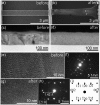Current induced polycrystalline-to-crystalline transformation in vanadium dioxide nanowires
- PMID: 27892519
- PMCID: PMC5125010
- DOI: 10.1038/srep37296
Current induced polycrystalline-to-crystalline transformation in vanadium dioxide nanowires
Abstract
Vanadium dioxide (VO2) exhibits a reversible insulator-metal phase transition that is of significant interest in energy-efficient nanoelectronic and nanophotonic devices. In these applications, crystalline materials are usually preferred for their superior electrical transport characteristics as well as spatial homogeneity and low surface roughness over the device area for reduced scattering. Here, we show applied electrical currents can induce a permanent reconfiguration of polycrystalline VO2 nanowires into crystalline nanowires, resulting in a dramatically reduced hysteresis across the phase transition and reduced resistivity. Low currents below 3 mA were sufficient to cause the local temperature in the VO2 to reach about 1780 K to activate the irreversible polycrystalline-to-crystalline transformation. The crystallinity was confirmed by electron microscopy and diffraction analyses. This simple yet localized post-processing of insulator-metal phase transition materials may enable new methods of studying and fabricating nanoscale structures and devices formed from these materials.
Figures




References
-
- Shibuya K., Ohnishi T., Lippmaa M., Kawasaki M. & Koinuma H. Single crystal SrTiO3 field-effect transistor with an atomically flat amorphous CaHfO3 gate insulator. Applied Physics Letters 85, 425–427 (2004).
-
- Zhou Y. & Ramanathan S. Correlated Electron Materials and Field Effect Transistors for Logic: A Review. Critical Reviews in Solid State and Materials Sciences 38, 286–317 (2013).
-
- Driscoll T., Kim H. T., Chae B. G., Di Ventra M. & Basov D. N. Phase-transition driven memristive system. Applied Physics Letters 95, 2–4 (2009).
-
- Ha S. D., Aydogdu G. H. & Ramanathan S. Metal-insulator transition and electrically driven memristive characteristics of SmNiO3 thin films. Applied Physics Letters 98, 98–101 (2011).
Publication types
LinkOut - more resources
Full Text Sources
Other Literature Sources

